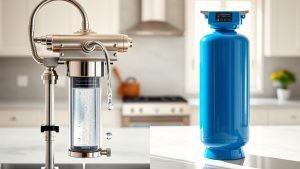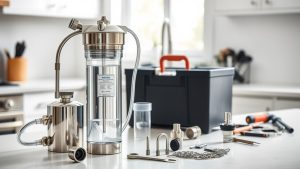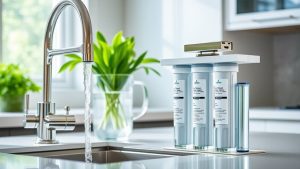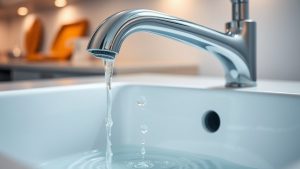How to Remove Lead From Water With This Step-By-Step Guide
Navigate the essential steps to eliminate lead from your water, unlocking a healthier life—discover the complete guide inside!
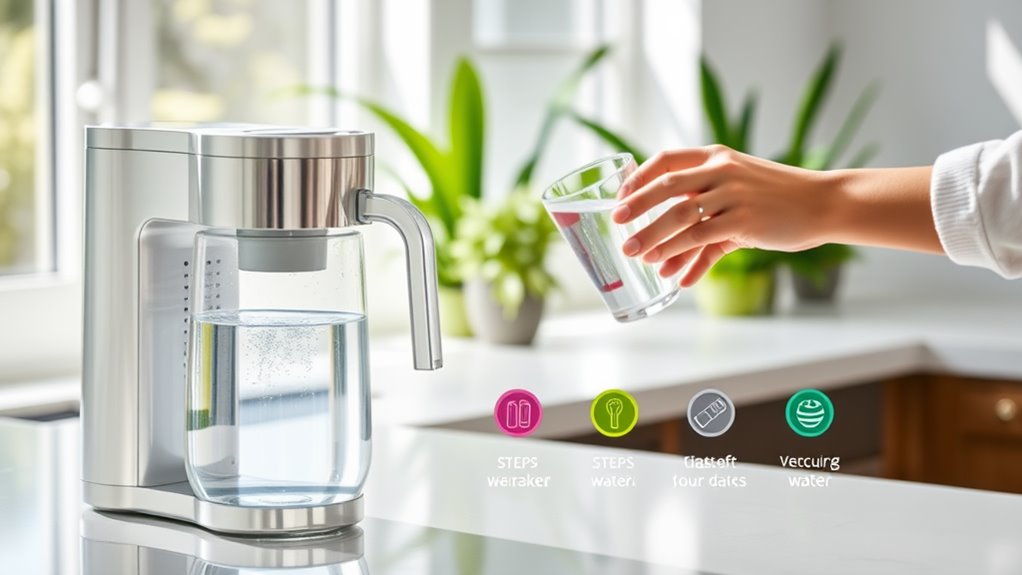
To remove lead from your water, start by testing it using certified labs or portable kits. If lead is detected, install an NSF-certified filter or consider a reverse osmosis system for effective removal. For long-term solutions, replace lead pipes with safer materials, and flush your pipes regularly before use. Maintain your treatment system with routine checks and filter replacements. These steps will greatly enhance your water quality, and there's more to discover about ideal solutions.
Understanding Lead Contamination in Water
Understanding lead contamination in water is essential for safeguarding public health, especially since lead can enter your drinking supply through various sources. Lead service lines pose a significant risk, while brass faucets and fixtures can still contain lead. Galvanized pipes may harbor particles from lead connections, and pre-1986 solder often had high lead content. Additionally, short pipes like goose necks and pigtails can introduce contamination. The health impacts are severe, particularly for children, leading to neurological damage and cognitive decline. Recognizing these sources allows you to take informed steps toward reducing lead exposure in your home's drinking water. Lead service lines run from the water main to internal plumbing and are a major source of lead contamination.
Testing Your Water for Lead
How can you be certain your drinking water is safe from lead contamination? Testing is essential, as lead is invisible, tasteless, and odorless. Health risks, particularly for children, emphasize the importance of regular assessments.
Sources of contamination often include plumbing systems, making it critical to use effective testing methods. You can choose from options like portable kits for quick assessments or more precise laboratory techniques such as atomic absorption spectroscopy.
Ascertain that testing is conducted by certified labs and interpret the results carefully to determine necessary follow-up actions. Regular testing can help protect you and your family from long-term health effects.
Effective Methods for Lead Removal
Several effective methods can help you remove lead from your drinking water, ensuring safety for you and your family.
Reverse osmosis and distillation are highly efficient techniques using physical processes to eliminate lead. Activated carbon filtration requires NSF-certified filters designed specifically for lead removal.
You can also reduce lead exposure by replacing lead pipes with safer materials and flushing your pipes before use.
For home solutions, point-of-use filters provide targeted protection, while whole-house systems offer broader coverage.
Choosing the Right Water Treatment System
Which factors should you consider when selecting a water treatment system to effectively remove lead from your drinking water?
First, look for systems specifically designed for lead removal, like ion exchange technology.
Consider systems tailored for lead removal, such as those utilizing ion exchange technology, for effective protection.
Second, verify the system meets NSF/ANSI standards, guaranteeing its effectiveness.
Third, evaluate your household's flow rate requirements to verify adequate water supply.
- Protect your family's health.
- Enjoy clean, safe drinking water.
- Save on bottled water costs.
Maintaining Your Water Treatment Solution
Maintaining your water treatment solution is essential for guaranteeing that lead removal remains effective over time. Start by routinely testing your tap water for lead and scheduling annual maintenance checks.
Regularly inspect system components for wear, replacing activated carbon filters every 6-12 months and reverse osmosis membranes annually. Implement pre-filtration to enhance efficiency and perform post-filtration tests to verify lead removal.
Monitor flow rates, check for leaks, and document maintenance records for future reference. Ascertain all parts are BPA-free and ISO certified, and plan for proper disposal of used filtration media to maintain system performance and safety.
Conclusion
In the quest for clean water, it's ironic that what flows from your tap could harbor lead, a heavy metal you wouldn't invite to dinner. By understanding contamination, testing your water, and implementing effective removal methods, you're not just ensuring safety; you're reclaiming your health. Choosing the right treatment system and maintaining it keeps the danger at bay. Ultimately, you're not just filtering water—you're filtering out potential harm, transforming your home into a sanctuary from unseen threats.
